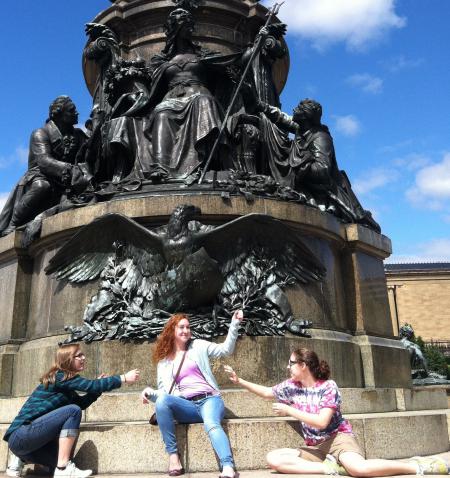Serendip is an independent site partnering with faculty at multiple colleges and universities around the world. Happy exploring!
Play in Confines

Since my trip into the city yesterday, I have slightly alerted my image of the city as a trove with treasures waiting to be discovered, to something with more of a reliable infrastructure. This view applies more to cities I am visiting for the first time or as a tourist, rather than being a resident or frequent visitor. Yesterday was my first time in Philadelphia. I have now visited New York, Paris, Salzburg, Toronto, Tokyo, and Philadelphia as a tourist. The last city I went to before Philadelphia was Tokyo. In Tokyo I got lost all the time, and held back tears on station platforms. When I was in Philadelphia I was with a group and could easily point out where we were on a map at all times. Although my Tokyo and Philadelphia experiences are a bit polar in terms of their potential unexpectedness, the mixture of the two recent experiences makes me feel city savvy. Being in Philadelphia was the first time that I was completely relaxed in a city that was not my own, even though it was my first time going there. I now feel like I have personal strategies on how to enjoy a new city. Before I go to a city I search online for things to do and learn my train stops. When I am in the city I do the things I planned and some I did not. I see the tourist sights, go down the main shopping street, I look around, ask people on the street where to go, and go down a couple streets just to see what is there. A bit of what I was expecting to be there and some left to chance.
I like a balance between definite and undefined plans. I know there is H&M that I want to get boots at, but I also give myself the room to find something new by randomly turning down a street to find a sculpture or The Reading Terminal Market. Central Philadelphia is on an uncomplicated grid with street numbers going one way and individually named streets going the other way. On one axis you know where you stand but on the other you don’t, which is a nice balance for me.
Walking around Philadelphia was a fun experience with my group. In some ways we were limited by our time, task, and surroundings, but in others we were free to exploring. Since there where so many statues around us, we chose to pose in pictures with them. We chose random statues, poses, faces, and the picture taker in the moment. We went to one place, and decided from there where to go next. At one point we went past a statue with the Shakespeare quote, “All the worlds a stage and all the men and women merely players.” That quote made me aware of us going around to statues and taking pictures and puling faces, almost like we were on a stage. This idea was reinforced when I saw recently married couples posing in LOVE Park with the “LOVE” sign. Attaching themselves in photos to the word love behind them with positive smiles, giving people and themselves an impression of their “LOVE.” Then the Shakespeare quote came back to my mind yet again with the monopoly references of the Pennsylvania Rail Road (“Only $100? I’ll take it!”) and the giant game pieces scattered around. I felt of myself as a bit of a pawn on stage because the reason I was in Philadelphia that day was the result of money and the eventual pursuit of it. But I was also there that day because of a possibly unlimited amount of serendipity and choices. The serendipity of getting into Bryn Mawr, then lotteried into the Play in The City Emily Bach Seminar, and not having an earthquake that day and the choice to go through with lots of things and so on. When my partner Natalie and me went to The Quiet Volume we had to follow directions and be engaged in order to experience something unexpected there. Once we did this, the piece naturally let us pull from the things happening around us and ourselves in order to make the experience unique. My overall experience in the city had many controlled aspects in which unexpectedness was able to live.
I agree partly with Zukin’s and Simmel’s view of the city. Zukin says that the “sole of the city” is in the “crowds” and “small shops” although I think this is true, this whole notion is too historically biased for me. The sole of the city is also in the McDonalds and the skyscrapers because people have partially voted for that based on what they buy. This idea goes into Simmel’s who said that, “Money is concerned with what is common to all, i.e. with the exchange value which reduces all quality and individuality to a purely quantitative level.” Like Zukin I don’t fully agree with this either, money is an abstract and fundamental building block in a city that can’t stop, but rather facilitates history, art, culture, and life from growing in it. These things work inside whatever confine, whether it is a paintbrush, an idea, a day, or a city.



